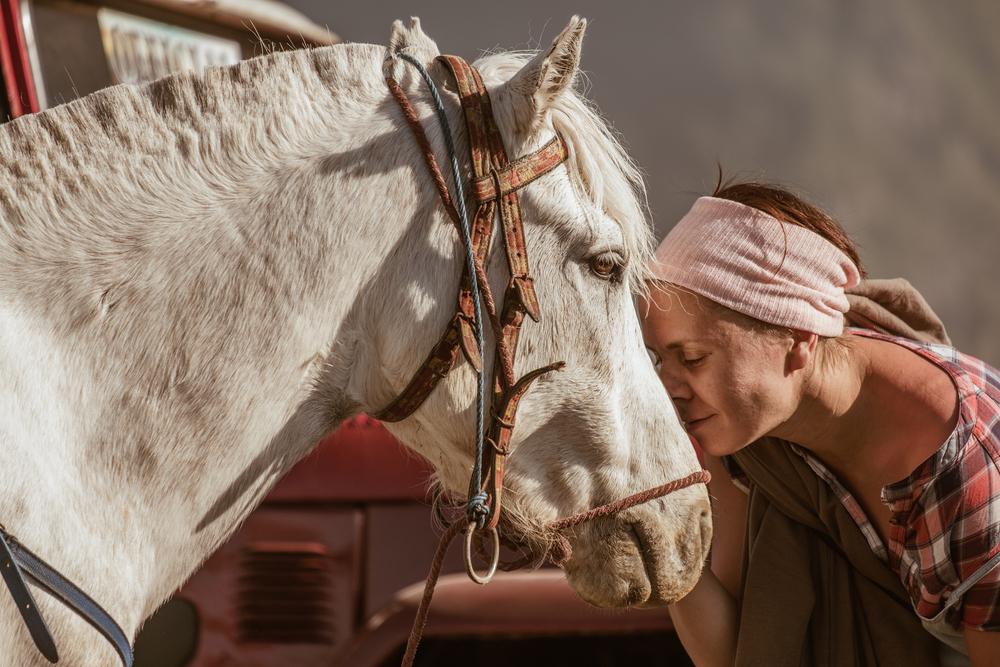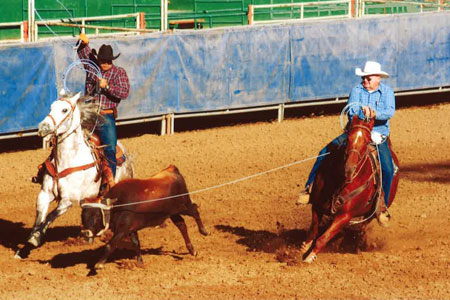Horses and Humans, Bonded Through Botulism
Posted on Categories Discover Magazine

Last month, a 1,400-pound horse named John competed with speed and style at the World Series of Team Roping in Las Vegas.
Fourteen months earlier, John couldn’t even stand without the help of six handlers and a sling.
After qualifying for a 2016 competition, John was found down at his owner’s ranch near Sacramento, felled by botulism. Despite receiving an antidote, he battled paralysis for 26 days. For most of his stay in an intensive care unit, he lay on the floor of his stall. He eventually lost 250 pounds, but he never stopped breathing.
“He definitely has attitude,” says John’s owner and lifelong horseman, Doug Parker. “When I first bought him in 2014, I remember calling my wife and saying, ‘This horse has all the tools, but he’s still a little green.’ As it turned out he was a handful! Much more of a project than I realized.”
That attitude probably helped John to survive.
A long-feared disease of humans, food-borne botulism also sickens birds, chickens and four-footed mammals, but this deadly toxin has also forged a unique bond between horses and humans. Not only do horses model the disease’s worst paralytic features, healthy, hyper-immunized steeds provide a life-saving antitoxin that’s used to treat humans. And in recent years, the development of better diagnostic lab tests for horses has paralleled the adoption of better diagnostics for humans and potentially poisoned foods.
Since 1910, when a German researcher named Leuchs made the first equine-sourced antiserum, horses repeatedly immunized with C. botulinum toxin have helped save human lives. In 2013, the US Food and Drug Administration approved the first equine antitoxin targeting all botulism subtypes. This new heptavalent treatment for humans, which is currently stockpiled by the U.S. government, was hailed as a valuable addition to the nation’s “emergency medicine cabinet” not just for unlucky eaters but possible victims of a future bioterrorist attack. It’s all thanks to our equine companions.
A Potent Killer
Seven botulinum toxins, designated A through G, are currently known to block the release of acetylcholine, an essential neural junction transmitter. The toxins are produced when Clostridium botulinum spores, widely dispersed in nature, encounter perfect conditions for germination: the absence of oxygen, a non-acidic pH, just the right amount of moisture and a warmish temperature (the optimum varies by subtype). Most horses suffer type A or B botulism, which typically occurs after they ingest spoiled or moldy feed. But enormous bales of hay can also spell disaster.
Consider a large outbreak of botulism in Oregon, summarized in a 2010 article in the Journal of Veterinary Diagnostic Investigation. The herd ate from bales of damp, matted bluegrass strewn along a creek bank during an unusually hot February. “After the first horse showed signs of botulism, 20 horses (including the sentinel case) died within three days, and four more horses died over the next six days,” the authors grimly recounted.
Given the warming trends throughout much of the world, I put two and two together.
“Could climate change increase the risk of botulism in horses?” I asked first-author Dr. Amy Johnson, a large-animal internist, neurologist and botulism specialist at the University of Pennsylvania, where she also works in a botulism lab testing animal samples from all over the country.
“I can’t say, ‘No,’” she replied, “but other factors include the economy and the availability of farmland.”
Because huge, round bales of hay are cheap to produce they became increasingly popular following the 2009 economic crash, Johnson went on to explain. Shrinking acreage has compounded the problem by decreasing local production of hay baled as traditional squares.
In John’s case, however, warm, matted hay was not the culprit fueling the crisis, according to his owner. Parker is far more suspicious of a grain-plus-molasses “treat” fed to his 11-year old American quarter horse gelding. That same mix scooped from the bottom of a lidded can repeatedly re-filled with 50-pound bags of grain was also fed to two other horses from Parker’s herd who suffered botulism a few weeks before John went down.
The first victim—a “tough little horse,” in Parker’s words—survived for less than 24 hours before succumbing to her disease; the second horse was hospitalized for only three days, then returned home. In each case, the afflicted animals were given roughly a liter of antitoxin-containing plasma (which can arrest but does not reverse botulism) as soon as they reached the University of California, Davis veterinary hospital.
“Before last year, I never heard of botulism in horses,” Parker said. “Now I’m thinking a lot more horses have it than are ever reported or even seen by vets.” Parker also knows that, unlike UC Davis, many veterinarians do not keep antitoxin on hand, further delaying treatment and worsening outcomes.
In addition to the speedy administration of neutralizing antibodies, what determines an individual horse’s survival remains a topic of ongoing interest and concern among vets and owners alike. In Johnson’s mind, there’s no doubt that psychological factors contribute.
“It’s very scary for a horse not to be able to get up. Some wear themselves out just trying,” she says.
“John was obviously as amazing athlete with real spirit and grit,” echoed Dr. Gary Magdesian, a UC Davis equine specialist who has personally cared for 15 to 20 horses with botulism over the last two decades.
Spirit aside, no adult horse with full-blown respiratory failure has yet been reported to beat botulism. Unlike in humans, in full-size equines, mechanical ventilation is simply too laborious, costly, and fraught with complications. On the other hand, what can make all the difference is a quick diagnosis along with the prompt infusion of antitoxin (the best commercial preparation currently available for horses covers types A through C) plus experienced supportive care.
Back to Roping
Once John was back on his feet, Parker gave him a couple of months to recover, then took him to Arizona for a roping tryout. “It felt like he was ready, but he wasn’t.” At that point, the rancher removed John’s shoes and put him out to pasture to gain more weight. “I’m not going to bring him back until he has two big old rump-cheeks,” he told himself.
The decision clearly paid off. Although Parker didn’t win prize money in Las Vegas, it wasn’t because of John. “I missed three steers I should have roped and broke a barrier,” he shrugged. “John was in as good a shape as ever.”
The final question—whether rates of equine botulism are currently climbing—is impossible to answer. Unlike their riders, there is still no mandatory reporting of horses with botulism.
